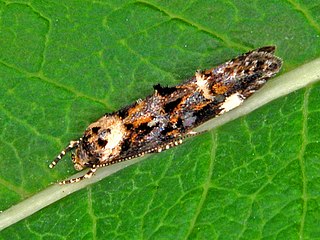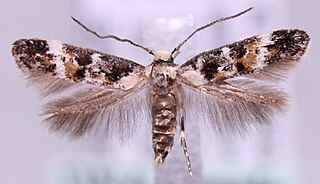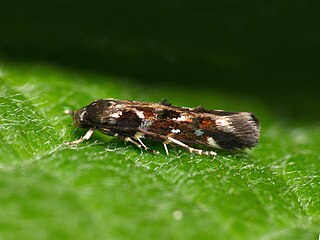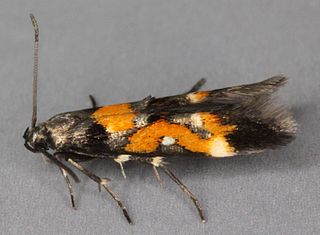
Spilonota ocellana, the bud moth, is a moth of the family Tortricidae. It is found in the Palearctic realm, from North Africa and Europe to Iran, eastern Russia, China, Korea, and Japan. It is also present on Madeira and in North America.

Sorhagenia is a genus of moths in the family Cosmopterigidae. The name honours Ludwig Friedrich Sorhagen.

Bucculatrix frangutella is a moth of the family Bucculatricidae. It was described by Johann August Ephraim Goeze in 1783. It is found in Europe.

Rhopobota naevana, the holly tortrix moth, holly leaf tier or blackheaded fireworm, is a moth of the family Tortricidae. It is found from Europe to eastern Russia, China, Taiwan, Mongolia, Korea and Japan. It is also present in India, Sri Lanka and North America.

Cosmopterix lienigiella is a moth of the family Cosmopterigidae. It is found from Fennoscandia to Spain, the Alps and Greece and from Ireland to Ukraine. It is also present in eastern Russia and Japan. It is the type species of the genus Cosmopterix.

Cosmopterix orichalcea is a moth of the family Cosmopterigidae. It is known from most of Europe east to Japan.

Mompha subbistrigella, the garden cosmet, is a moth of the Momphidae family found in most of Europe.

Pancalia leuwenhoekella is a moth in the family Cosmopterigidae.

Sorhagenia janiszewskae is a moth in the family Cosmopterigidae. It is found from Great Britain to Russia and from Fennoscandia to France, Switzerland, Austria, Croatia, Hungary and Romania. It has also been reported from Portugal, the Caucasus and western Transcaucasia.
Sorhagenia lophyrella is a moth in the family Cosmopterigidae. It is found in most of Europe, Asia Minor and the Caucasus.

Agonopterix conterminella is a moth of the family Depressariidae which is found in Asia, Europe and North America. It was described by Philipp Christoph Zeller in 1839 from a specimen found in Augsburg, Germany. The larvae feed on the terminal shoots of willows.

Agonopterix yeatiana is a moth of the family Depressariidae. It is found in most of Europe.

Mompha conturbatella, also known as the fireweed mompha moth, is a moth in the family Momphidae found in Asia, Europe and North America. It was first described by Jacob Hübner in 1819.

Mompha lacteella is a moth in the family Momphidae found in the Palearctic including Europe.

Mompha propinquella is a moth in the family Momphidae found in Europe.

Mompha terminella is a moth in the family Momphidae found in Europe and North America.

Scrobipalpa costella is a moth of the family Gelechiidae. It is found in western Europe.

Mompha locupletella is a moth in the family Momphidae that can be found in the Palearctic including Europe.
Sorhagenia fibigeri is a moth in the family Cosmopterigidae. It is found in Asia Minor.

Scrobipalpa samadensis, the buck's-horn groundling, is a moth of the family Gelechiidae. It is found in most of Europe and Russia.


















